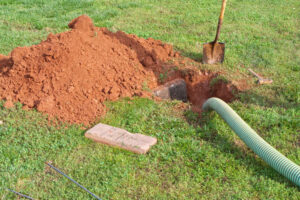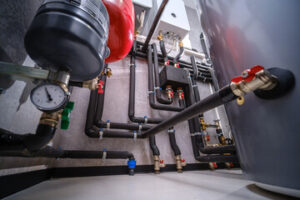A septic tank pump is a component of your household sewage system. When a company comes to pump your septic tank, they use a giant vacuum that sucks the water and sludge out of the tank.

The wastewater in the tank goes through a treatment process as it flows into a drain field or leach field. The septic tank contains bacteria that break down the waste in an oxygen-free environment. For more information, visit https://www.septictankarmadale.com.au/.
Your septic tank system is a series of underground pipes that absorb wastewater from your home. It’s important to keep in mind that septic systems are complex, so problems can arise that require professional help to fix. However, there are also some common problems that homeowners can try to resolve on their own.
The typical septic tank is a large, dual-chambered buried container made of concrete, fiberglass or polyethylene. Wastewater enters the tank from your house, where gravity and bacterial action separate it into heavy solids and lighter liquids. The solids settle down to the bottom of the tank while the sludgy sludge floats on top. The liquid waste, known as effluent, then drains through a series of porous drainage pipes to a leach field or drain field (also called a “leach pit”).
Your septic tank pump is located inside your septic tank or right outside it. The pump is designed to remove the wastewater from the top of your septic tank, moving it into the drain field. This prevents solid waste from entering the absorption field and damaging it.
The septic tank pump is powered by a motor and is triggered to activate when the effluent level in your septic tank rises to the top of the tank. As the septic tank pumps away the sludge and sewage, the effluent then flows back into the tank to start the process all over again.
You can reduce the amount of wastewater that goes into your septic tank by using low-flow toilets, showerheads and faucets, fixing leaky fixtures, and conserving water use in general. Additionally, you can minimize the amount of solids that go into your septic tank by installing an effluent filter.
Despite all of these precautions, it’s still important to have your septic tank pumped every ten years. When a company comes to your house to pump your septic tank, they will take a giant truck with a huge suction hose that literally sucks up the sewage from your septic tank. This sewage is then transported to a septic processing site where it is safely handled.
Installation
A septic tank pump is a vital part of your home’s plumbing. It moves wastewater from your household toilets into the tank to separate solid wastes from liquid sewage. The heavy solids settle to the bottom of the tank where bacteria break them down to form sludge. The lighter solids, such as fats and grease, rise to the surface and float to the top of the tank where the sewage flows into a distribution box.
The distribution box evenly distributes the septic tank wastewater into pipes that drain into your absorption field. This prevents a single trench from overflowing and prevents the entire system from becoming overloaded. The septic tank pump also keeps the sewage from flowing back into the house if the absorption field becomes overflowing.
You’ll need to have your septic tank inspected regularly. A professional can inspect the tank for cracks, corrosion, and other problems. They’ll also check the alarm float for proper operation. Some problems are easy to fix, such as readingjusting the float control switch. Other issues are a little more difficult, and it’s always best to leave them to the pros.
Your septic tank should be buried underground in your yard. It should be a minimum of 16 inches deep, and the top of the tank should be at least four feet above ground level. Before digging, it’s important to get a land survey from an experienced local professional. This will ensure that the tank is located within your property’s boundaries, which can avoid a costly legal headache later.
Most people choose to have a concrete tank installed because it’s durable and watertight. It costs more to install than a fiberglass tank, though, and it may require more digging and equipment. You’ll also need to install a pump vault, which protects the septic tank or pump.
Make sure your septic tank pump is properly sized for your household’s needs. A larger tank can cost more to install, and a smaller one can cause problems like overflowing or clogging. Your plumber will help you select a septic tank that’s just right for your home.
Maintenance
Septic systems are designed to break down and filter the waste from the home’s plumbing. But, the tank must be pumped periodically to remove solid waste that cannot be broken down or filtered. It’s also important to maintain other components of the septic system in order to avoid leaks and other costly problems.
A septic pump requires electricity to operate, so be sure to shut off power to the pump before working on it. If you have a newer model, there is likely a switch inside the tank that will allow you to turn off or on the pump. If you have an older model, you will need to physically disconnect the pump from the septic system. If you are unable to get to the switch or your pump has stopped working, contact Jones Plumbing & Septic Tank Service for help.
Oftentimes, the problem is not with the pump itself but with the sensors that tell it when to turn on and off. The float controls can become stuck open or closed or can be damaged by debris in the septic tank. If the float control breaks, the septic tank cannot drain wastewater into the drain field. In this case, one of our technicians may need to remove debris from the septic tank or replace the float control altogether.
In addition to keeping the septic tank pump in good working condition, there are many other maintenance tasks that will extend the life of your septic system. It’s a good idea to divert downspouts, lawn sprinklers and other surface water away from the drainfield. Also, keep cars and lawn equipment off the septic tank pad. They can crush or damage the tank lid and cause spills, clogs and other expensive problems.
It’s a good idea to set up a schedule to have your septic tank pumped. It’s a much better option than waiting until it is full and then having a service company rush to pump it out. Sticking to a regular pumping schedule will reduce the cost per pump since there is less waste to remove from the tank.
Replacement
As with anything that relies on human-made technology, septic tank pumps can experience some failures from time to time. While you can help reduce the number of breakdowns by practicing proper maintenance, it’s impossible to prevent all incidents entirely. If you notice any signs that your septic system pump needs to be replaced, it’s important to act quickly.
If you’re lucky, the problem will be easy to solve. For example, if the float control that activates your septic tank pump becomes restrained or blocked by debris inside the pump, you can simply readjust it to make it work again. The float creates a pressure gradient that keeps the waste moving into and from your septic tank. If the float isn’t properly adjusted, it could cause the waste to back up into your home plumbing.
More serious problems may occur that require the assistance of a professional. For instance, if you hear loud, grinding noises coming from your septic system pump, this is usually an indication that the motor within is not operating correctly. Similarly, vibrations or shaking may indicate that the pump is working too hard or inefficiently.
Another common problem occurs when the septic tank lid cracks. If you have a concrete or metal tank, a crack can lead to leaks and expensive repairs. While a crack can sometimes be filled with a resin or concrete compound, large cracks will likely require a replacement lid made from polyethylene, fiberglass-reinforced plastic, or a cement-like material.
Your septic tank pump is an incredible piece of machinery that works tirelessly to collect and remove all your household waste from the drain field. While you can help its lifespan by reducing the amount of water that enters it, even this system will eventually fail. When it does, the resulting problems can be very unpleasant. By following the tips in this article, you can ensure your septic tank pump lasts for as long as possible.




